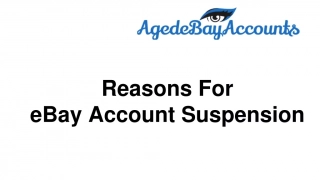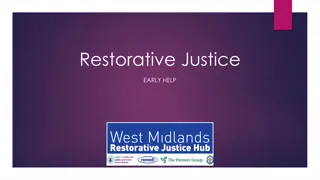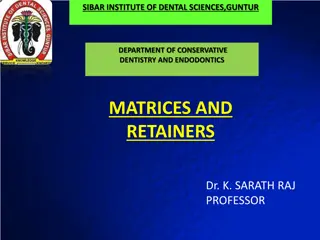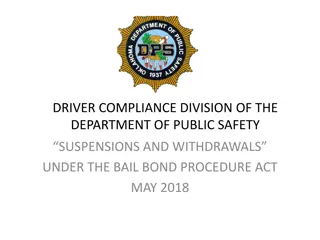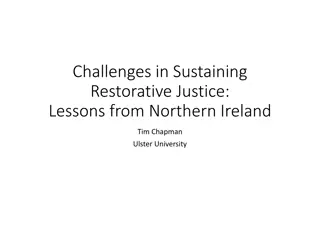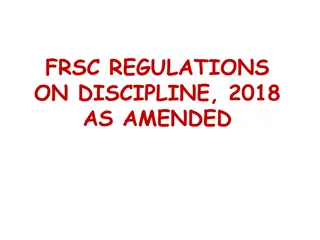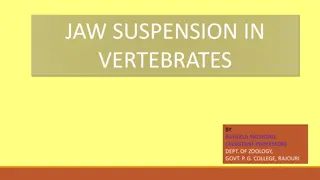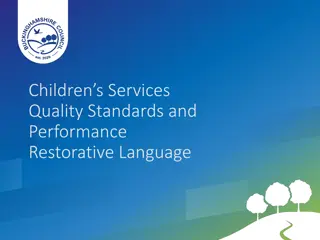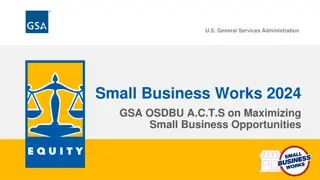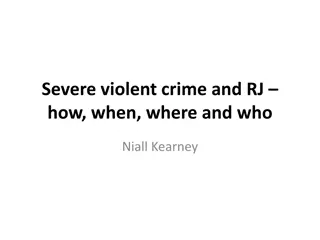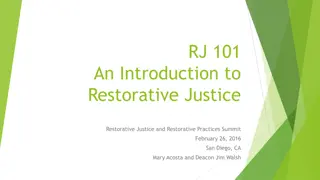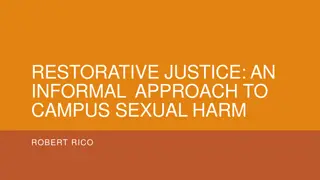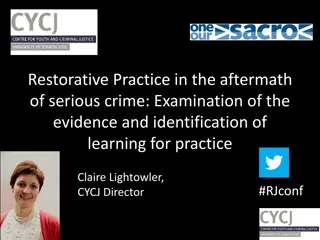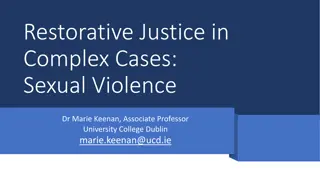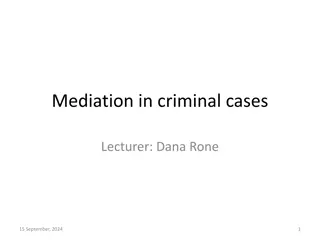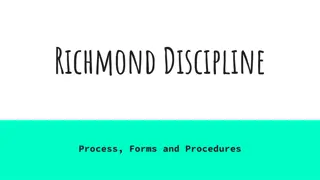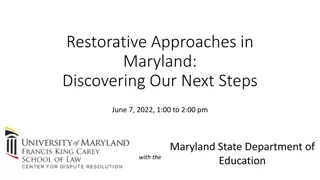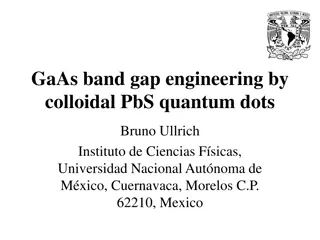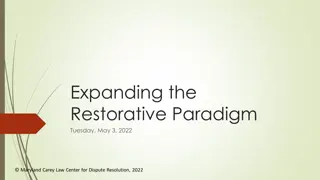Restorative Practices in SW-PBS: Reducing Suspension Needs
This presentation explores integrating restorative practices in a school-wide positive behavior support system to decrease the necessity for suspensions. It discusses the origins of zero-tolerance policies, the negative impacts of suspension/expulsion on students, and the potential of restorative justice to address behavioral issues while prioritizing the needs of the community, victims, and offenders. Emphasizing a shift towards a more holistic and inclusive approach, the content advocates for moving away from punitive measures towards fostering a safer and more supportive school environment.
Download Presentation

Please find below an Image/Link to download the presentation.
The content on the website is provided AS IS for your information and personal use only. It may not be sold, licensed, or shared on other websites without obtaining consent from the author.If you encounter any issues during the download, it is possible that the publisher has removed the file from their server.
You are allowed to download the files provided on this website for personal or commercial use, subject to the condition that they are used lawfully. All files are the property of their respective owners.
The content on the website is provided AS IS for your information and personal use only. It may not be sold, licensed, or shared on other websites without obtaining consent from the author.
E N D
Presentation Transcript
Integrating Restorative Practices in a SW-PBS System: Can we reduce the need for suspension? Tichelle Bruntmyer University of Missouri
WHATS THE PROBLEM?
Zero Tolerance Policies What s your gut reaction?
Where it came from Gun-Free Schools Act (1994) Congressional response to rising juvenile arrest rates of late 80s/early 90s State laws that mandated expulsion of any student bringing a weapon to school for at least a year = federal education funds
Where it went Suspension/expulsion for misdemeanors and minor offenses Approximately 2 million children a year 5% for weapon possession 43% for insubordination
Where it Goes TX study found 1 non- weapon suspension/expulsion tripled a student s chances for JJ involvement
Whats the problem? Deprives students of educational opportunities ODRs ISS/OSS 1 in 14 students in 2006 school year Expulsion Increases likelihood for JJ involvement Fails to make schools safer
IS RESTORATIVE JUSTICE THE ANSWER?
Definition of Restorative Justice a way of responding to criminal behaviour by balancing the needs of the community, the victims and the offenders. It is an evolving concept that has given rise to different interpretation in different countries, one around which there is not always a perfect consensus. (United Nations, 2006)
Definition of Restorative Justice a broad term which encompasses a growing social movement to institutionalize peaceful approaches to harm, problem-solving and violations of legal and human rights (Center for Restorative Justice, 2011)
Definition of Restorative Justice Rather than privileging the law, professionals and the state, restorative resolutions engage those who are harmed, wrongdoers and their affected communities in search of solutions that promote repair, reconciliation and the rebuilding of relationships. Restorative justice seeks to build partnerships to reestablish mutual responsibility for constructive responses for wrongdoing in our communities. (Center for Restorative Justice, 2011)
Restorative Justice in 3s 3 assumptions Needs are created when people and relationships are harmed Needs lead to obligations The obligation is to put right the harm (Van Wormer & Walker, 2013)
Restorative Justice in 3s 3 principles Repairs the harm caused by the wrongdoing (restoration) Encourages responsibility for actions (accountability) Involves the victims and community (engagement) (Van Wormer & Walker, 2013)
Restorative Justice in 3s 3 underlying values Respect Responsibility Relationship (Van Wormer & Walker, 2013)
Restorative Justice in 3s 3 central questions Who has been hurt? What are their needs? Who has the responsibility to restore the relationship? (Van Wormer & Walker, 2013)
Restorative Justice in 3s 3 stakeholder groups Victim and their family Offender and their family Relevant community (Van Wormer & Walker, 2013)
Pause for thought. Consider the application of Restorative Justice with our kids What was it designed to address? What types of issues are we wanting it to address in schools? What adaptations would be needed for application in school?
RESTORATIVE JUSTICE IN SCHOOLS
RJ in Schools Many names Restorative practices, processes, approaches, discipline Serves as an alternative to zero tolerance Grounded in respect, responsibility, & relationships Necessitates a shift from exclusion to connectedness with the school Focuses on community-based problem solving
RJ in Schools Meant to address harm and Create climate to promote healthy relationships Build community Develop social-emotional understanding and skills Enhance teaching and learning
RJ in Schools Restorative Circles In the classroom: Build community Problem solve Foster student-teacher relationship Provide space for respectful dialogue to democratically establish classroom values
RJ in Schools Restorative Circles Outside the classroom: May include conferencing with administrators May include peer juries May be used for more intense interventions such as: Repairing damage Reintegrating back into school after suspension/expulsion Resolving differences
One Suggestion (Pavelka, 2012)
Early Reports of RJ in Schools MN DoE 45-63% reduction of behavior referrals and suspensions in 2 schools, increase in academics Cole Middle School, CA 87% reduction in suspensions W Philadelphia High School, PA 52% reduction in violent acts and serious incidents in 07- 08; additional 40% in 08- 09 Denver Public Middle Schools 90% reduction in ODRs and OSS across 7 schools
An example: ED WHITE MIDDLE SCHOOL SAN ANTONIO, TX
Ed White Middle School San Antonio, TX Restorative Discipline 3 year project beginning 2012-2013 school year Goal: decrease instances of Bullying Discipline referrals Assignments to DAEP Improve relationships between teachers, administrators, and students
Ed White Middle School San Antonio, TX Demographics Students (6th thru 8th grades) 985 30% African American 53% Hispanic 13% Caucasian 4% Asian/Pacific Islander 81.6% economically disadvantaged Teachers 15% African American 20% Hispanic 61% Caucasian
Ed White Middle School San Antonio, TX Questions: What is the impact of RD on risk factors (e.g. suspension, absenteeism, bullying) of 6th grade students? What is the impact on 6th grade school climate? What is the experience of administrators who use RD for student misconduct and teachers who use RD in their classrooms?
Ed White Middle School: Implementation Whole-school approach Start with 6th grade, add a grade each year Leadership Response Team + outside consultant Teacher training: 2 days Restorative justice and conducting restorative circles 6th grade teachers, principal, assistant principal, all staff associated with discipline and counseling
Ed White Middle School: Implementation Classroom circles Initially used to build community, problem solving class issues, teaching, & classroom management Later, restorative circles for discipline Eventually, 4th period used for RD circles Leadership Response Team (LRT) Dealt with more serious offenses Outside consultant Meet with LRT and teachers Visit classrooms Co-facilitate circles, when needed
Ed White Middle School: Restorative Circles/Conferences Circle/Conference Agreement Forms: Name and grade of participants Description of incident Agreement Details How will harm be repaired? How will harm be avoided in the future? How will person who did the harm give back to the community? What support will be given to the person harmed? Monitoring Plan Signatures
Ed White Middle School: Restorative Circles/Conferences Circle-It Forms Requested by students Student uses to initiate circle or conference Student indicates urgency of meeting today or tomorrow Primarily used to deal with peer conflict
Ed White Middle School: Restorative Circles/Conferences 120 100 80 RD Conferences Circle It! Forms 60 40 20 0 Sept Oct Nov Dec Jan Feb Mar Apr May
Ed White Middle School: Rates of Suspension 6th Grade % Change 2011-2012 2012-2013 Partial day ISS 75 167 (RD) +123% Partial Suspension 12 11 .8% ISS 468 329 30% OSS 66 11 84%
Ed White Middle School: Infractions Failure to follow direction Tardy (ODR) Disrupt class 3 strikes Walk out of class Absense/Truancy Detention no show Profanity Verbal confrontation Physical confrontation Inappropriate remarks Horseplay 0 100 200 300 400 500
Ed White Middle School: Bullying & RD Implementation 10 9 8 7 6 Bullying RD Implementation 5 4 3 2 1 0 Sept Oct Nov Dec Jan Feb Mar Apr May
Ed White Middle School: Findings OSS: 84% decrease ISS: 30% decrease School Climate Survey: parents and students had stronger sense of disciplinary fairness Use and acceptance of RD was not consistent across teachers Students responded favorably (e.g. Circle-it) Teachers who used RD in the classroom improved relationships with students
Ed White Middle School: Recommendations Teacher training includes practical application through concrete examples/role play PD opportunities in RD throughout the year Create a teacher handbook of philosophy, practices, and procedures Plan for RD in non-classroom areas Provide better/frequent feedback to teachers Engage students through peer-mediated circles Involve parents in circles, when appropriate
Pause for thought 84% reduction in OSS and 30% reduction in ISS, but These figures do not indicate a change in the frequency or nature of misconduct or more major offenses. Rather, they show the success of the school s commitment not to extrude students or use punitive approaches to discipline. (p. 6) What could explain this finding?
IS THERE A BETTER APPROACH?
Restorative practices within PBIS SW-PBIS Provides a tiered structure for organizing levels of prevention and making decisions regarding support needs Offers a way to collect and analyze data Goals of RJ and PBIS are similar, so how can they work together?
RJ in Tier 1 Goal of Tier 1: Establish a predictable and positive environment Direct teaching of expectations RJ Inclusion: Circles Periodically at the beginning of the school day to review or re-teach Used to pre-correct behavior How would theft of property affect the class? Discuss issues that are concerning the class Current or local events that might be concerning
RJ in Tier 2 Goal of Tier 2: Provide additional support for students who aren t successful at the universal level RJ Inclusion Peer juries Proceed with caution! Group-based restorative protocols Includes person who committed harm, person harmed, teacher, and any other relevant stakeholders Plans to prevent future occurrence
RJ in Tier 3 Goal of Tier 3: To provide individualized support for students with the most pervasive needs RJ Inclusion Administrative conferencing Student(s) committing harm, student(s) harmed, teacher, school administrator, parents of involved students Develop plan to repair damage, teach appropriate replacement behaviors, restore relationships, prevent future occurrences
DATA! How many whole class (tier 1), small group (tier 2), administrative (tier 3) conferences are you having? Who initiates advanced tier conferences? (i.e. teachers, admin, students) Is the integration of restorative practices having an influence on ODRs, suspensions, and expulsions? If not, why?
Food for thought Conduct a resource analysis How can this fit within our current system? What will it cost us in time, personnel, etc.? What are our needs according to our data? Don t settle Decreases in suspension and expulsion are GREAT! but it s not enough Continue to strive for high rates of appropriate behavior by teaching expectations
Food for thought Remember what you know about behavior Inappropriate behavior will continue to occur unless you teach an acceptable replacement Be patient! RJ involves empathy
THANK YOU!! Tichelle Bruntmyer dtb8db@mail.missouri.edu
References Armour, M. (2013). Ed White middle school restorative discipline evaluation: Implementation and impact, 2012/2013 sixth grade. The Institute for Restorative Justice and Restorative Dialogue. Austin: The University of Texas at Austin. Gonzalez, T. (2012). Keeping kids in schools: Restorative justice, punitive discipline, and the school to prison pipeline. Journal of Law & Education, 41 (2), 281-335. Kang-Brown, J., Trone, J., & Daftary-Kapur, T. (2013). A generation later: What we've learned about zero tolerance in schools. Center on Youth Justice. New York: VERA Institute of Justice. Pavelka, S. (2012). Practices and policies for implementing restorative justice within schools. The Prevention Reseracher, 20 (1), 15-17. van Wormer, K., & Walker, L. (2013). Restorative justice today: Practical applications. Los Angeles: Sage Publications.


